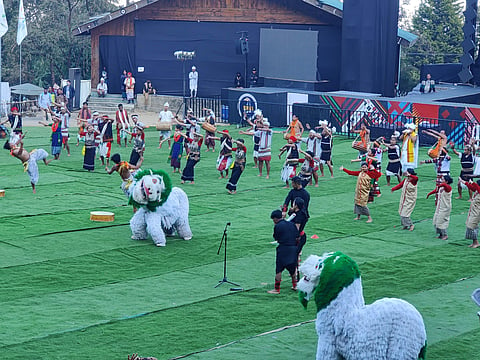
- LIFESTYLE
- FASHION
- FOOD
- ENTERTAINMENT
- EVENTS
- CULTURE
- VIDEOS
- WEB STORIES
- GALLERIES
- GADGETS
- CAR & BIKE
- SOCIETY
- TRAVEL
- NORTH EAST
- INDULGE CONNECT

Cultural extravagance, unity and celebration of diversity — these are some of the traits that defined this year’s Hornbill Festival, an annual event featuring all the ethnic groups in Nagaland. Held at the Naga Heritage Village in Kisama near Kohima between December 1 and 10, 2022, the festival turned out to be a plethora of new experiences and an absolute eye-opener for someone who didn’t know much about the North East.
One of the first things we notice after entering the Heritage Village is the Chief of Naval Staff, Admiral R Hari Kumar, flagging off a motorcycle expedition by the Indian Navy, a 24-day rally in the North East to raise awareness about Indian independence and recruit more volunteers from the area. Fifteen riders clad in denim and riding jackets — each on a Royal Enfield motorcycle — driving through the crowd majestically while Shankar Mahadevan’s Hum Taiyar Hain played in the background, made for quite a goosebump inducing, patriotic sight!
We move on to the never-ending rows of textile, pottery, woodcraft and food shops and spot exquisitely crafted black earthenware that is native to the Tangkhul tribe in Longpi (Nungbi) village at Manipur, hand-woven dupattas and winter shawls, vivid beaded jewellery, bamboo baskets and more, making us feel spoilt for choice. We also come across interesting wine options made of kiwi, hot sauces infused with peach and passion fruit, and dried meat pickles that promise to bring in the heat of the Naga Morich (the Ghost Pepper), touted to be one of the spiciest peppers to ever exist.
As we walk through the crowd, we spot wood and thatch huts that each showcase the attire, weaponry, crockery and accessories special to each of the tribes in Nagaland, including the Chakhesangs, Konyaks and the Kachari Morung, which comprises smaller communities like the Dimasas, Meches and Boros. We also see representatives from each of these tribes, dressed in their colourful native attires and huddled around cosy bonfires. We consider ourselves lucky for getting the chance to witness this beautiful moment — the spirit of unity in diversity, with each tribe coming together to celebrate their culture, music, food, and art forms.
The highlight of our trip to the Hornbill Festival was, however, the performances of the folk dance form native to each of the Seven Sisters. The charmingly playful and adorably fluffy Snow Lions from Sikkim/Arunachal Pradesh, featuring artistes in furry costumes of white and green with the face of a snow lion, danced and rolled in rhythm to music, occasionally bounding up to the audience to play with us! This was followed by a mindblowing martial arts performance of Thang Ta from Manipur, Laho from Meghalaya, Hojagiri from Tripura, Popir from Arunachal Pradesh and more, during which groups of dancers from each of the seven states came forward into the arena and moved in tempo to the beat of the drums. Guess they don’t call the Hornbill Festival ‘a festival of festivals’ for nothing!
We leave the Heritage Village with a heart filled with warmth and a feeling of serenity, taking home the satisfaction of getting a peak into this joyous cultural celebration that was a world of its own. While our visit to the Hornbill Festival was quite brief, it was in no way unforgettable.
Hornbill trivia 101
Do you know how and when the tradition of the Hornbill Festival began? And what it signifies?
It all starts with the hornbill — a bird that has been depicted in several Naga myths, folklore, songs and dances. Its feathers were used to decorate the headgear of the Naga warriors. Since the Nagas believe that the hornbill is a harbinger of good and a symbol of valour, it has been respected by the community for ages and subsequently, became the face of this festival.
Initiated in 2000, the main objective of the Hornbill Festival was to unite the 16 major tribes of Nagaland. Since their cultures and customs differed and resulted in conflict for decades, the idea was to celebrate all tribes for their diversity and unite them. Now, the tribes are known as one: the Naga people.
The next Hornbill Festival is expected to take place on November 23, 2023.
Nearest railhead and airport: Dimapur. Flights connect Chennai to Dimapur via Kolkata and Guwahati. Trains connect Chennai to Dimapur every Tuesday.
praveena @newindianexpress.com
@PraveeParthiban